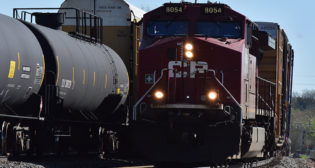
Amtrak ACS-64: Speed, power, efficiency
Written by AdministratorIn June 2009, Amtrak called for proposals for up to 70 new electric locomotives. The key requirements were conformity to all FRA regulations, Buy America compliance, acceleration capability to avoid impacting Acela Express high speed train schedules, and the capability to haul 18 single level Amfleet coaches at a sustained speed of 125 mph.
Amtrak awarded a contract in October 2010 to Siemens Industry, Mobility Division, for 70 “American Cities Sprinter” ACS-64 electric locomotives. Designed to operate at speeds up to 125 mph between Boston and Washington D.C. and 110 mph between Philadelphia and Harrisburg, the 8,580-hp locomotives will eventually replace Amtrak’s entire existing electric fleet.
The ACS-64 offers high efficiency, reduced life cycle cost, and better reliability and availability than Amtrak’s existing electrics. In terms of traction capability with the maximum specified trainload, the ACS-64 can accelerate 18 Amfleet coaches with a Head End Power (HEP) load of 1000kW to 125 mph in just over eight minutes.
The ACS-64 is an integral monocoque wide-body, double-cab design suited for push-pull operation. The carbody is comprised of four major elements—underframe, sidewalls, operator cabs, and three detachable roof sections. It is designed to allow compression forces of 800,000 pounds of buff load and is equipped with an AAR F-type coupler with a push back mechanism to achieve full anticlimber engagement.
Instead of a “conventional” mechanical safety concept in accordance with American Crash Standard AAR S-580 with collision and corner posts, the ACS-64 features a front end Crash Energy Management (CEM) system that provides better safety to crews while offering the advantage of lower weight and better reparability.
The ACS-64 will have a center walk-through engine room. More space is available for components, maintenance access is much better, and component thermal effects are minimized, enabling better ventilation. This is the standard engine room layout for the Siemens European EuroSprinter and Vectron locomotives, and most of the electrical components are identical.
Since Amtrak’s NEC has three different a.c. catenary voltages, the ACS-64 is designed for 25kV 60Hz, 12.5 kV 60 Hz, and 12 kV 25Hz. A rotary switch in the converter connects the transformer windings for the required configuration. The traction control system consists of two cubicles located in the center of the locomotive on both sides of the walk-through, each containing components for one two-axle truck as well as the HEP supply.
Each converter cubicle has two water cooled input inverters (four-quadrant choppers) and three water cooled output inverters with IGBT power semiconductors. The two input inverters feed one common d.c. link for the three output inverters in one cubicle. Two of these output inverters are connected to the two a.c. traction motors of one truck in a single-axle control configuration, and one output inverter provides the redundant feed for the HEP and locomotive auxiliary systems.
Traction and locomotive control is performed by the Siemens SIBAS® 32 control system. The core of the control system is the Multi-Vehicle-Bus (MVB), interfacing with the subsystem control computers, all the I/O stations, as well as the Man-Machine Interfaces such as controls and displays on the engineer’s console.
The ACS-64 contains a 100% redundant HEP and AUX inverter system. It can operate at full speed at 100% traction power with one failed HEP inverter, or with a potential delay with one or two traction inverter or traction motor failures. System-criticalcomponents such as traction motors, inverters, and control system components are derived from service-proven systems.
One of the new features of this locomotive is that it is not equipped with a dynamic brake resistor. Instead, regenerative braking up to 100% rated power is possible, depending on the actual receptiveness of the grid. Main line electric locomotives typically spend approximately 8% of operational time in electrical brake mode, and given today’s average electrical energy cost, this, combined with highly efficient electrical components, can add up to considerable energy savings.
Michael Latour is Manager Sales & Project Management Locomotives, Siemens Mobility Division.



